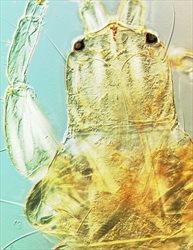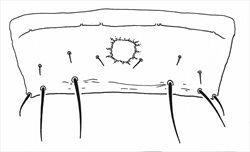
Head & pronotum

Antenna female aptera, and segments III-IV of macroptera

Heads of female macroptera & aptera

Male sternite VIII
Females sometimes fully winged, but females and males also fully apterous. Macropterae with body light brown, tube and antennae yellow; legs largely yellow with femora weakly shaded, fore wings pale; apterae all yellow with weak shadings medially on tergites. Antennae 8-segmented; VIII constricted to basal pedicel; in apterae segment III with 2 sense cones, IV with 2 or 3 sense cones; macropterae with 3 on III and 4 on IV. Head longer than wide, projecting weakly in front of eyes, cheeks almost parallel, without prominent setae; postocular setae very long and finely pointed, wide apart; apterae with eyes small and directed forwards; maxillary stylets retracted to eyes, close together medially in head. Pronotum without sculpture medially, with 4 pairs of long, weakly pointed major setae, anteromarginals scarcely larger than discal setae; prosternal basantra absent. Fore tarsus of female with minute tooth. Metanotum without sculpture medially. Fore wing parallel sided, with duplicated cilia. Abdominal tergite I, the pelta, with lateral margins confluent with anterior margin of tergite II; tergites II–VII with two pairs of weakly sigmoid wing-retaining setae in macropterae but these setae small in apterae, marginal setae long and pointed; tergite IX setae S1 pointed, longer than tube.
Male apterous, ocelli absent; tarsal tooth large; tergite IX setae S2 short and stout; sternite VIII with small circular pore plate medially.
The genus Hoplothrips includes about 120 named species, but there are no modern identification keys to any substantial number of species. The most common species are known to exist as both winged and wingless morphs. Moreover, these species exhibit considerable sexual dimorphism, and males of the same species vary in body size, with some structures exhibiting patterns of allometric growth. As a result, species identification is often difficult (Mound & Walker, 1986; Kobro & Rafoss, 2006; Okajima, 2006). Amongst the Hoplothrips species recorded in Britain, unicolor (along with semicaecus) is unusual in that flightless individuals are apterae rather than micropterae. Moreover, these apterae have fewer sense cones on antennal segments III and IV than do the macropterae. However, it shares with longisetis the presence of elongate pointed S1 setae on the ninth tergite.
Breeding on the branches and trunks of dead Pinus trees in association with the fungus Trichaptum abietinum [previously Polystictus], presumably feeding on the hyphae.
Locally common in northern parts of Scotland, but only recorded prior to 1965 and following major storm damage to Pinus forests in 1939. It has also been reported from Sweden and Norway (Gertsson, 2015), but is otherwise known only from New York and from Algeria (Mound et al., 1976).
PHLAEOTHRIPIDAE - PHLAEOTHRIPINAE
Hoplothrips unicolor (Vuillet)
Trichothrips unicolor Vuillet, 1914: 313
Trichothrips flumenellus Hood, 1931: 159
Gertsson C-A (2015) An annotated checklist of Thysanoptera (thrips) from the Nordic countries. Entomologisk Tidskrift 136 (4): 185–198.
Kobro S & Rafoss T (2006) Identification of adult males and females of Hoplothrips species (Thysanoptera: Tubulifera) known from Norway, and some deductions on their life history. Entomologica Fennica 17: 184–192.
Mound LA, Morison GD, Pitkin BR & Palmer JM (1976) Thysanoptera. Handbooks for the Identification of British Insects 1 (11): 1–79.
Mound LA & Walker AK (1986) Tubulifera (Insecta: Thysanoptera). Fauna of New Zealand 10: 1–140.
Okajima S (2006) The Suborder Tubulifera (Thysanoptera). The Insects of Japan 2: 1–720.